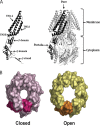The MscS and MscL families of mechanosensitive channels act as microbial emergency release valves
- PMID: 22685280
- PMCID: PMC3430326
- DOI: 10.1128/JB.00576-12
The MscS and MscL families of mechanosensitive channels act as microbial emergency release valves
Abstract
Single-celled organisms must survive exposure to environmental extremes. Perhaps one of the most variable and potentially life-threatening changes that can occur is that of a rapid and acute decrease in external osmolarity. This easily translates into several atmospheres of additional pressure that can build up within the cell. Without a protective mechanism against such pressures, the cell will lyse. Hence, most microbes appear to possess members of one or both families of bacterial mechanosensitive channels, MscS and MscL, which can act as biological emergency release valves that allow cytoplasmic solutes to be jettisoned rapidly from the cell. While this is undoubtedly a function of these proteins, the discovery of the presence of MscS homologues in plant organelles and MscL in fungus and mycoplasma genomes may complicate this simplistic interpretation of the physiology underlying these proteins. Here we compare and contrast these two mechanosensitive channel families, discuss their potential physiological roles, and review some of the most relevant data that underlie the current models for their structure and function.
Figures



Similar articles
-
Exploring the diversity of mechanosensitive channels in bacterial genomes.Eur Biophys J. 2021 Jan;50(1):25-36. doi: 10.1007/s00249-020-01478-1. Epub 2020 Nov 26. Eur Biophys J. 2021. PMID: 33244613
-
Responses of Bacillus subtilis to hypotonic challenges: physiological contributions of mechanosensitive channels to cellular survival.Appl Environ Microbiol. 2008 Apr;74(8):2454-60. doi: 10.1128/AEM.01573-07. Epub 2008 Feb 29. Appl Environ Microbiol. 2008. PMID: 18310427 Free PMC article.
-
MscS-like mechanosensitive channels in plants and microbes.Biochemistry. 2013 Aug 27;52(34):5708-22. doi: 10.1021/bi400804z. Epub 2013 Aug 15. Biochemistry. 2013. PMID: 23947546 Free PMC article. Review.
-
Sensing and responding to membrane tension: the bacterial MscL channel as a model system.Biophys J. 2012 Jul 18;103(2):169-74. doi: 10.1016/j.bpj.2012.06.021. Epub 2012 Jul 17. Biophys J. 2012. PMID: 22853893 Free PMC article. Review.
-
Characterizing the mechanosensitive response of Paraburkholderia graminis membranes.Biochim Biophys Acta Biomembr. 2020 Apr 1;1862(4):183176. doi: 10.1016/j.bbamem.2020.183176. Epub 2020 Jan 7. Biochim Biophys Acta Biomembr. 2020. PMID: 31923411
Cited by
-
Dynamics of Escherichia coli's passive response to a sudden decrease in external osmolarity.Proc Natl Acad Sci U S A. 2016 Oct 4;113(40):E5838-E5846. doi: 10.1073/pnas.1522185113. Epub 2016 Sep 19. Proc Natl Acad Sci U S A. 2016. PMID: 27647888 Free PMC article.
-
Stress Physiology of Lactic Acid Bacteria.Microbiol Mol Biol Rev. 2016 Jul 27;80(3):837-90. doi: 10.1128/MMBR.00076-15. Print 2016 Sep. Microbiol Mol Biol Rev. 2016. PMID: 27466284 Free PMC article. Review.
-
Phosphatidylinositol is crucial for the mechanosensitivity of Mycobacterium tuberculosis MscL.Biochemistry. 2013 Aug 13;52(32):5415-20. doi: 10.1021/bi400790j. Epub 2013 Aug 1. Biochemistry. 2013. PMID: 23875651 Free PMC article.
-
Structural insights into the Venus flytrap mechanosensitive ion channel Flycatcher1.Nat Commun. 2022 Feb 14;13(1):850. doi: 10.1038/s41467-022-28511-5. Nat Commun. 2022. PMID: 35165281 Free PMC article.
-
"Force-From-Lipids" mechanosensation in Corynebacterium glutamicum.Biophys Rev. 2019 Jun;11(3):327-333. doi: 10.1007/s12551-019-00524-3. Epub 2019 May 4. Biophys Rev. 2019. PMID: 31055761 Free PMC article. Review.
References
-
- Balleza D, Gomez-Lagunas F. 2009. Conserved motifs in mechanosensitive channels MscL and MscS. Eur. Biophys. J. 38:1013–1027 - PubMed
Publication types
MeSH terms
Substances
Grants and funding
LinkOut - more resources
Full Text Sources

